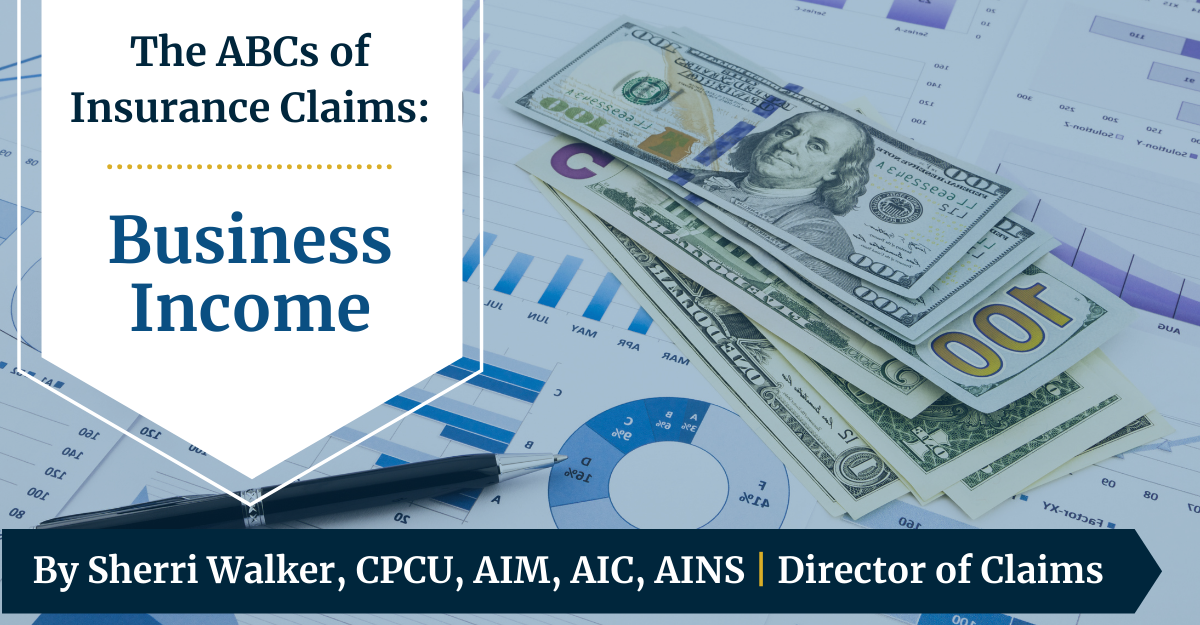Welcome to the ABCs of Insurance claims. Over the next few months, Sherri Walker, Sentinel’s Director of Claims will address an aspect of claims handling for every letter of the alphabet to help provide a better understanding of the claims process.
B is for Business Income
Business Income coverage, also known as Business Interruption or Time Element coverage, is an extremely important but often overlooked coverage on Commercial Property policies.
Suffering any type of property loss as a business can be costly. First, there is always a deductible to consider, which can be high, as well as any additional out-of-pocket expense for limited or excluded damages. But imagine not being able to operate for an extended period due to this loss. A business that is unable to operate cannot generate revenue, and that creates an impact on the owner, employees, and other people that rely on that business. This is where Business Income coverage can step in and protect your business.
Business income is often defined as the net income (which can be either a profit or a loss) plus normal continuing operation expenses. This coverage is designed to cover the loss of revenue when you cannot operate your business. Even if you have an overall operating net financial loss you should consider business income coverage.
When it comes to Business Income, the policy applies to the “period of restoration”.
This is defined as the period of time that begins when covered damage forces a business to suspend its operations and ends when the covered damage is or reasonably could have been repaired. Suspension of business is deemed to be “the partial slowdown or complete cessation of business activities”. Typically, policies will spell out a time limit or dollar limit that applies. Coverage ends earlier than the end of the period of restoration, or when the limit of the policy is reached.
Keep in mind the suspension of operations must be caused by direct physical loss or damage to property by a covered cause of loss. That means that the proximate cause of the loss must be one that the policy does not exclude. For example, if a long-term mold issue unrelated to sudden damage causes a restaurant to close, there would be no coverage for Business Income because this is not a covered cause of loss. Further, if the business simply slows down because of seasonal changes in a tourist town, this would not be covered because there is no direct physical damage. Additionally, there can be some limited coverage consideration for shut down under Civil Authority, but this is typically limited to 4 weeks and requires a 72-hour time deductible.
Most policies will have a “time deductible” versus a flat dollar amount which means that this coverage does not begin until a specified period of time (usually 24, 48, or 72 hours) elapses. In the event of a fire, you may have a dollar deductible that applies to the physical damage and a time deductible that applies to the Business Income loss as well.
So how is the amount of Business Income loss determined?
It’s important to understand the difference between Gross Income versus Net Income. Net Income is calculated as Gross Income (the total amount of money earned) less expenses such as overhead, cost of materials, taxes & interest. This coverage pays for Net Income plus continuing expenses, which can include ordinary payroll.
For example, if a building that houses a business has a water leak that requires the business to suspend for a month, there will still be utilities to be paid in that month, as well as potential payroll and other fees/dues based on the type of business. Those continuing expenses would be part of the Business Income loss. On the other hand, if that building burns down and will be rebuilt over a period of 8 months, then some expenses such as internet and phone may be temporarily shut down, and employees may be furloughed without pay. Those costs would not be included, as they are no longer being incurred during the suspension.
With all those factors in mind, typically when the actual amount of Business Income loss is being determined, a forensic accountant may be retained, and the Insurance Carrier will request documentation of that loss from an Insured. That documentation can include prior tax returns, accounting and payroll records, and contracts that may be lost as a result of the business having to shut down.
There is additional coverage that can be added to Business Income, known as Extra Expense.
We will dig deeper into this topic in a future article in this series, but briefly, these coverages address things that a business may do to mitigate the period of time they have to suspend operations. This could include renting mobile office space to continue operations or renting a piece of equipment to temporarily replace comparable disabled machinery. For businesses that have contracts to fulfill, this can keep the company from losing additional funds and can help keep business relationships intact.
Determining a proper Business Income limit is more than just an educated guess.
It should be delved into deeply by assessing the potential financial effect a covered loss may have and the estimated time of suspension. Sometimes an inadequate limit can result in a penalty at the time of loss adjudication. Thus, the time to review your limit for adequacy is prior to that loss that suspended your operation. Your risk advisor is an excellent source of information. Most often, completion of a Business Income worksheet is required to determine a limit, and this exercise should be performed annually – even more often if the operations or exposures of the business vary greatly in a policy term.
While a baseline version of this coverage may be included in many coverage forms, there are typically options to endorse extra coverage limits and extensions. Your Sentinel Client Executive and Account Advisor are great resources to confirm the levels of your existing coverage and explore additional options available to you. The dedicated team of insurance professionals at Sentinel is here to assist you in safeguarding your success.


